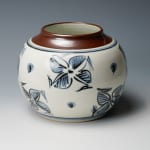Tomimoto Kenkichi 富本憲吉 1886-1963
H 15.2 × Dia 19.0 cm
Further images
-
(View a larger image of thumbnail 1
)

-
(View a larger image of thumbnail 2
)

-
(View a larger image of thumbnail 3
)

-
(View a larger image of thumbnail 4
)

-
(View a larger image of thumbnail 5
)

-
(View a larger image of thumbnail 6
)

-
(View a larger image of thumbnail 7
)

-
(View a larger image of thumbnail 8
)

-
(View a larger image of thumbnail 9
)

-
(View a larger image of thumbnail 10
)

ong considered as one of the most influential post-war artists from the Kyoto pottery scene, Tomimoto Kenkichi has been canonized into the modern history of Japanese pottery as the father of modern ceramics. Born in Nara in 1886, he was designated a Living National Treasure in 1955 for his technical innovations in porcelain & stoneware. He was the first potter ever to be designated the title.
Tomimoto trained initially as an architect and interior designer, and following his graduation, he travelled to London (1908-1910) where he spent some time sketching in the Victoria and Albert Museum. This was his first exposure to the work of Ogata Kenzan (1663-1743) and to seeing ceramics as ‘art objects’, beyond functional ceramics. He returned to Japan in 1910, and at a raku firing, he met and befriended Bernard Leach. Together they both experimented and developed their ceramic skills. He taught and worked in Tokyo (1913-1926) where he coined the phrase ‘Never develop a pattern from a pattern’, an expression emphasizing originality. He travelled extensively during this time and continued to develop his skills by visiting ceramic production centres across Japan. This included time in Kanazawa where he specifically studied the production of red-ground Kutani ware. Finally, he ended up teaching and working in Kyoto (1946-1963) where he developed the body of richly ornamented work that he is best known for today.









